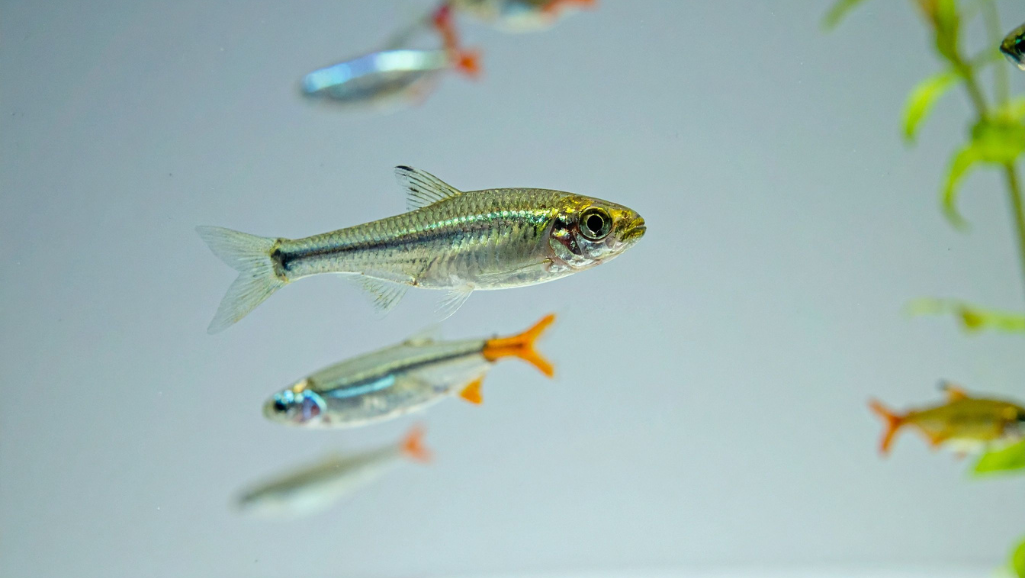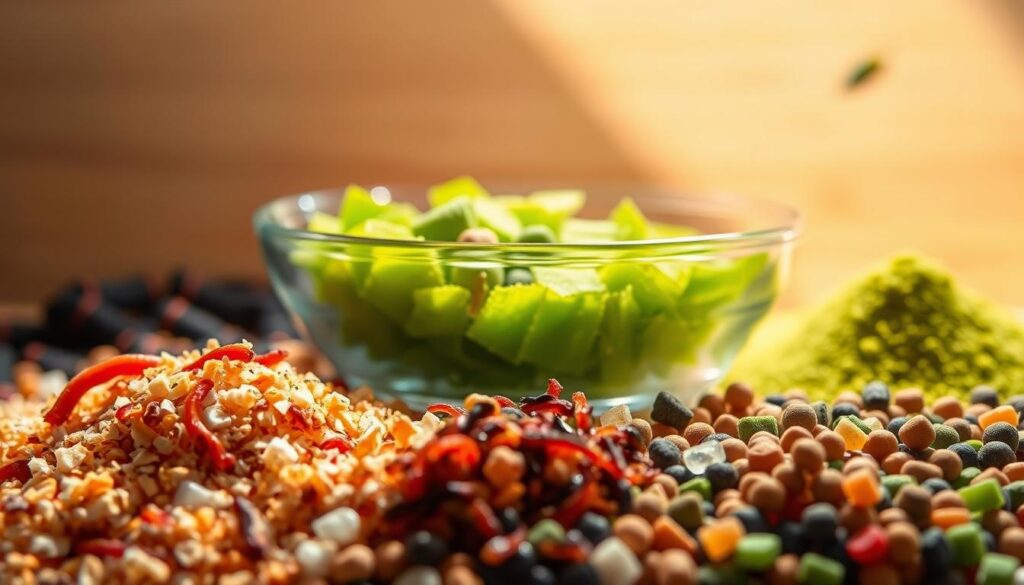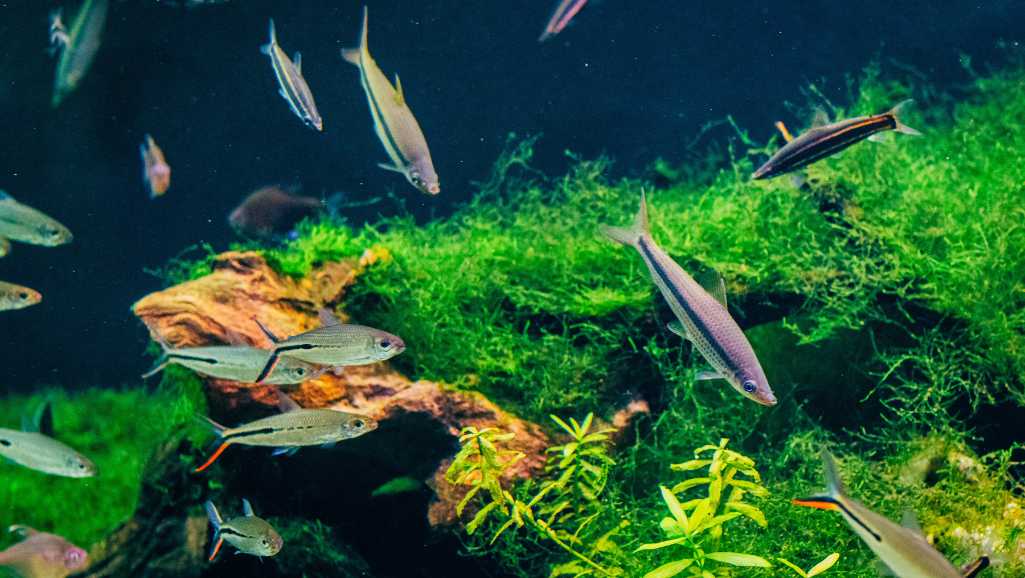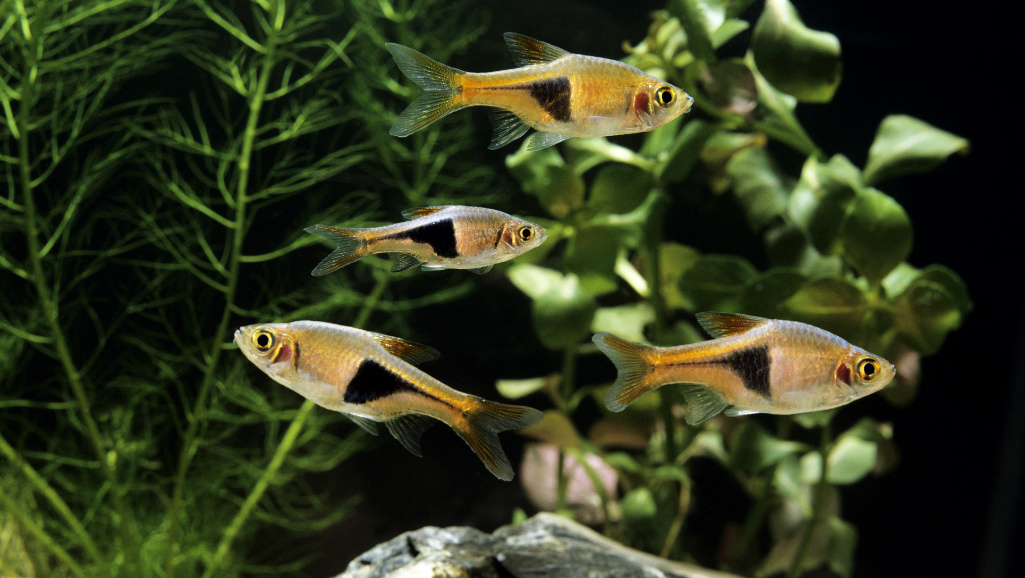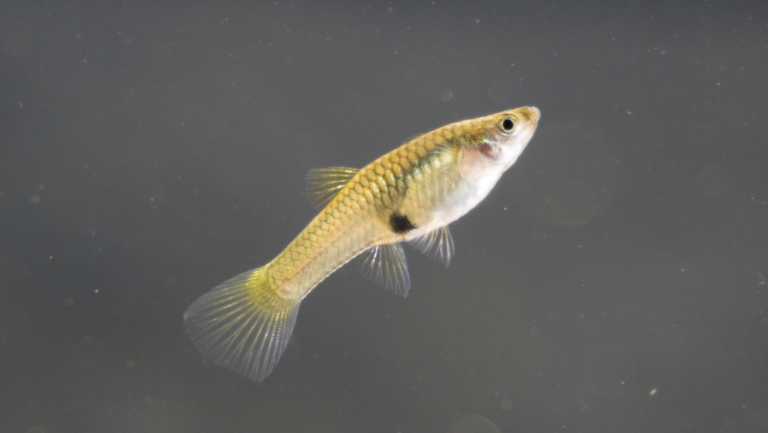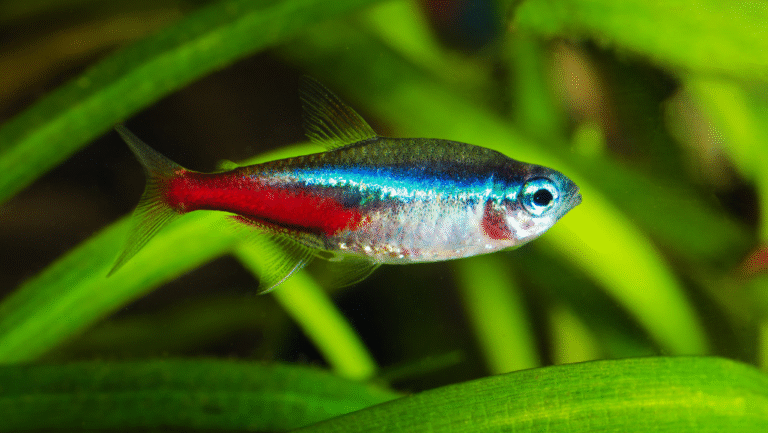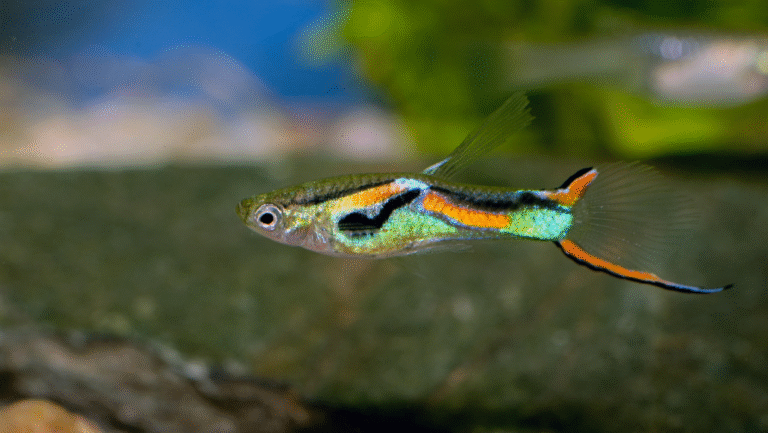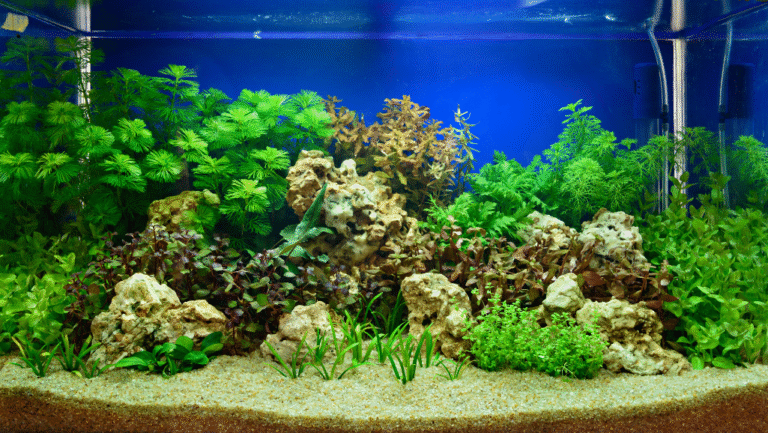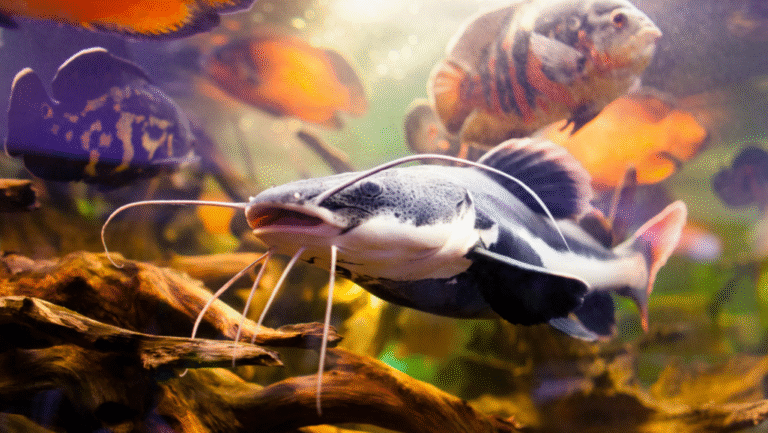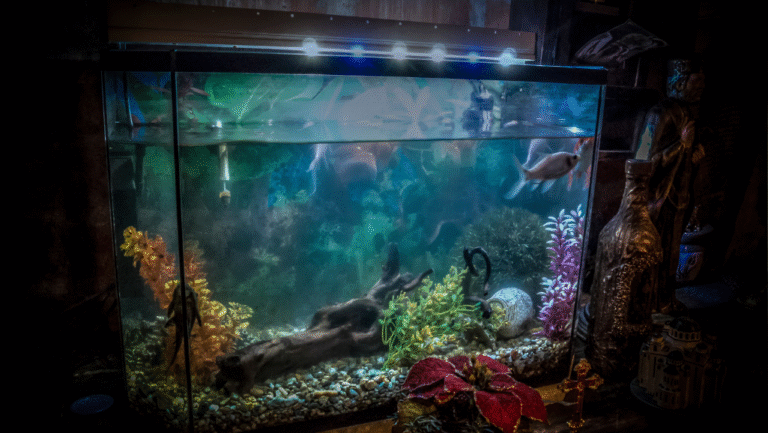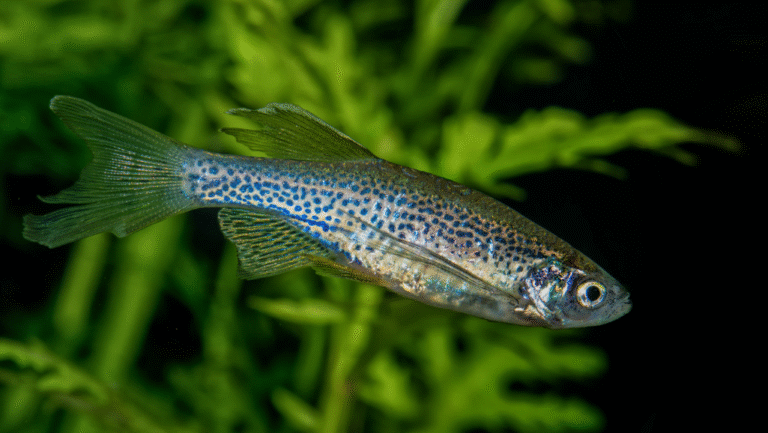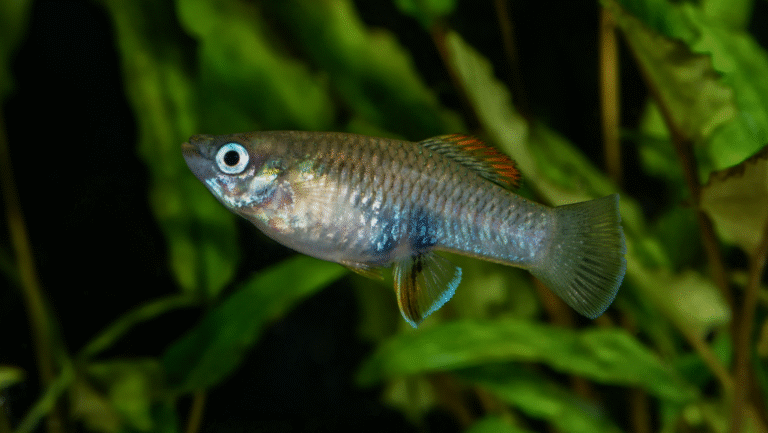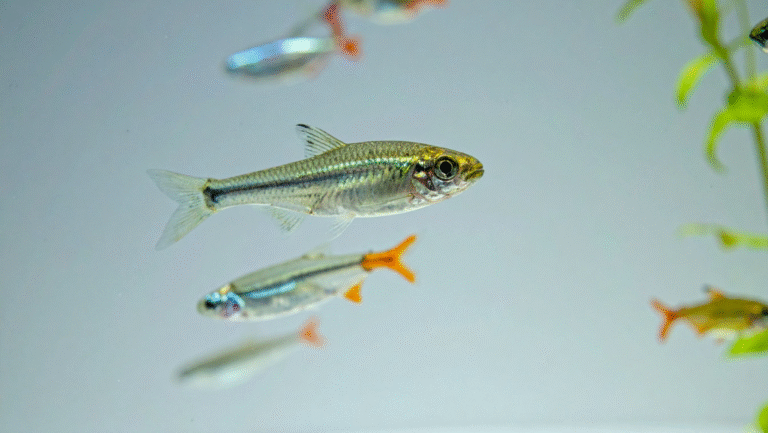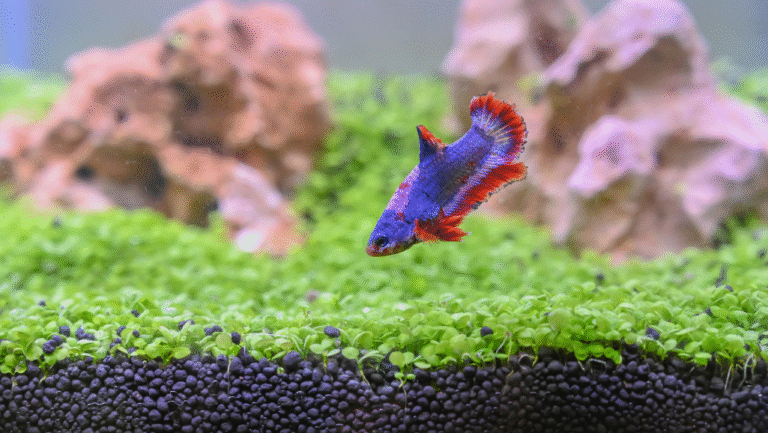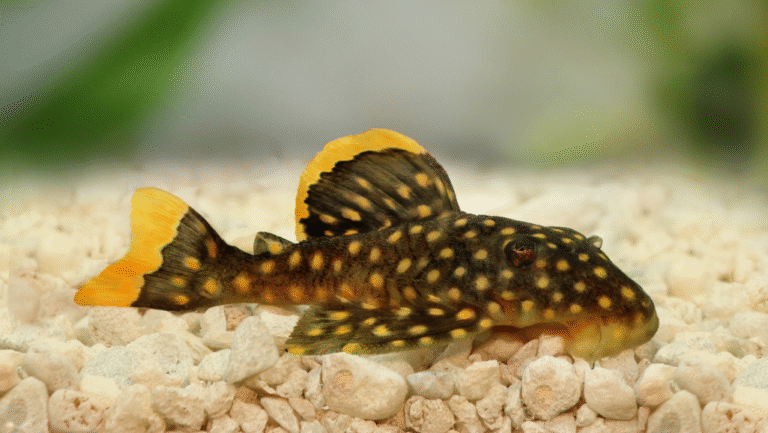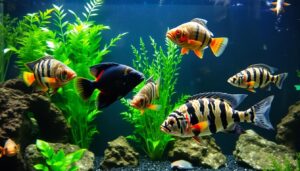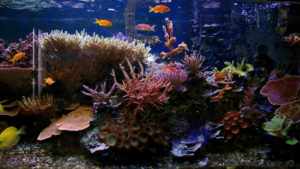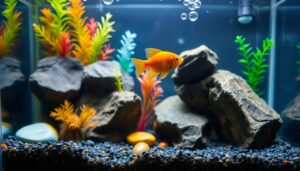The pygmy corydoras is a tiny South American dwarf catfish that brings steady charm to a nano freshwater setup. At about one inch when adult, this silver-bodied species wears a thin black stripe and fills a small aquarium with lively, confident movement.
These peaceful fish school near midwater, perch on leaves, and often dart up to gulp air — a normal behavior adapted to calm, plant-rich waters. A well-planted tank with gentle flow and soft, slightly acidic to neutral water keeps them comfortable.
Keep a group of at least 8–12 in a 10-gallon or larger tank so the school displays natural activity. Thoughtful scaping, good filtration, and cooler temperatures around 72–78°F help the tiny catfish thrive and become a centerpiece rather than a background cleaner.
Key Takeaways
- Small size, big personality — ideal for nano aquascapes.
- Schooling of 8–12 boosts confidence and display behavior.
- Soft, slightly acidic to neutral water and cooler temps suit them.
- Planted, low-flow setups mimic their South American habitat.
- Surface gulping is normal and not a sign of poor health.
Pygmy Corydoras
Before you buy, learn how size, sex, and subtle patterns separate closely related small species. This snapshot helps plan stocking, breeding, and display goals.
Species snapshot: size, lifespan, and native range
This tiny cory catfish reaches about an inch at maturity and shows a streamlined body. Females are slightly larger and rounder than males, which helps when sexing a group.
With steady care they live roughly three to five years. In the wild they inhabit calm tributaries of the Nanay River (Peru), the Aguarico (Ecuador), and the Madeira basin in western Brazil.
How to tell pygmaeus from habrosus and hastatus
Identification matters because each species behaves a bit differently in a tank. C. pygmaeus displays a thin horizontal black stripe on a clean silver body.
- C. habrosus – uneven, salt-and-pepper pattern with a broken stripe and a striped tail.
- C. hastatus – large black spot at the tail base flanked by white dots.
These small fish often hover midwater more than other catfish. When you see that behavior plus the thin stripe, you’re likely looking at pygmaeus. Check labels and patterns at the store — mixes and mislabels are common.
Setting Up the Ideal Nano Aquarium
Designing a compact, calm habitat is the first step toward a thriving nano community. Choose a longer footprint when possible so a lively school can shoal, hover, and explore without feeling crowded.
Tank size, space, and school size for a happy community
Minimum recommended: a 10-gallon tank with horizontal space helps behavior and reduces stress. Keep a school of at least 8–12 so shy individuals gain confidence and your display feels animated.
Substrate, plants, and hardscape that protect delicate barbels
Use fine sand to protect barbels and support natural foraging. Add dense plants — anubias, floating roots, and fine-leaved stems — plus driftwood and leaf litter to create hiding lanes and perches.
Filtration, flow, lids, and acclimation
Select a sponge filter or an adjustable-output unit for gentle, even flow. Fit a tight lid to prevent jumps as the fish surface to gulp air.
“Acclimate calmly and efficiently — minimize stress to avoid toxin release in small aquariums.”
- Pre-filter intakes with sponge guards to protect small fish.
- Float and drip acclimation works well; don’t drag the process out.
- Maintain stable water at 72–78°F and stock slowly to let the biofilter mature.
Water Parameters and Quality Management
Keeping water steady rewards you with active, confident schooling and fewer surprises. Aim for predictable routines so the aquarium feels like a small, calm stream.
Temperature, pH, and mineral balance
Target the 72–78°F range and hold pH roughly between 6.2 and 7.5. Keep KH near 6–10 dKH to avoid sudden swings that stress small fish.
Soft water, tannins, and gentle flow
Favor soft, slightly acidic to neutral water. Add leaf litter or botanicals for tannins if you want a tea-stained look that soothes this species.
Use low to moderate flow so filtration cleans quietly without pushing the school from its midwater hangouts.
Testing, changes, and routine care
- Test regularly and log readings to detect trends early.
- Perform small, consistent water changes rather than large, sporadic swaps.
- Match replacement water with remineralizers or conditioners when tap water is hard or variable.
“Stability matters more than perfection—choose realistic targets and keep them steady.”
Feeding the Pygmy Cory: Small Foods, Big Nutrition
Choose soft, sinking bites and occasional live protein to meet the needs of delicate-mouthed fish. A steady rotation of staple items and tiny treats keeps a school healthy and curious.
Daily staples that work
Sinking wafers, nano pellets, and Repashy gel foods form the backbone of a balanced diet. These items soften, sink, and invite slow grazing so shy individuals can feed.
Protein boosts and treats
Supplement with very small live or frozen options like cyclops, daphnia, and baby brine shrimp. These protein-rich bites are easier for tiny mouths than frozen bloodworms, which are often too large.
Practical feeding strategy
- Build a staple rotation using foods like wafers, pellets, and gel so nutrition stays varied.
- Feed after lights dim or just before to give slow bottom and midwater grazers first access.
- Portion small meals and place fragments in several spots so timid pygmy cory catfish can eat comfortably.
- Rinse frozen treats to cut excess phosphates and watch uneaten bits to protect water quality in a small aquarium.
“The right food, format, and timing turn feeding into enrichment for the whole school.”
Behavior, Schooling, and Peaceful Tank Mates
Watch how this tiny school carves the middle space of the tank with graceful, synchronized motion. Their midwater swimming gives a planted aquarium life at eye level. At dusk they become more active and curious.
Midwater activity and surface gulps
Hovering and brief surface visits are normal. They dart up to gulp air from time to time. Excessive surface breathing can signal low oxygen or water issues that need correction.
Choosing calm companions
Select peaceful nano community fish such as neon tetras, chili rasboras, celestial pearl danios, and otocinclus. A calm betta can work if it shows no aggression. Avoid any tank mate big enough to eat small tank dwellers.
- Keep a confident group: a steady group unlocks bold, social behavior.
- Snails and dwarf shrimp coexist well as cleaners; adults are ignored but tiny shrimp fry may be eaten while foraging.
- Provide cover: plants and wood break lines of sight and reduce chasing.
- Multiple feeding spots: ensure slow or shy fish get food when faster feeders are present.
“Measured stocking, kind neighbors, and thoughtful scaping produce a serene, endlessly watchable tank.”
Breeding Pygmy Corydoras in the Home Aquarium
Spawning in a home tank responds best to richer diets and a brief, cooler water refresh to mimic nature. Condition a colony of six or more adults with protein-rich meals for several weeks. Add a slightly cooler partial water change the day before you expect courtship to encourage receptivity in females and attentiveness in males.
Preparing and triggering spawning
Feed small, frequent portions of live or frozen protein to build egg condition. Keep plants like java moss and floating roots ready—these fine plants collect single sticky eggs placed one by one as part of the natural process.
Egg care and hatching
Inspect eggs daily. Fertilized eggs stay translucent yellow-tan; infertile eggs turn opaque white and must be removed to prevent fungus. Many breeders transfer eggs to a well-aerated container and add methylene blue or alder cones to reduce fungus risk.
Raising the fry
Hatching typically occurs in 2–5 days depending on temperature. Start fry on microscopic foods such as infusoria or 5–50 micron prepared diets. Gradually introduce live baby brine shrimp and soft gel foods as they grow.
“Tiny, consistent feedings and frequent small water changes protect water quality and speed healthy growth.”
- Tip: Keep dense plants to shelter eggs and supply microfauna for early fry food.
- Timing: Watch the first week closely—feed tiny amounts multiple times daily and increase portions as fry develop.
- Goal: Move to larger foods and more space once fry are robust and free-swimming.
Health, Diseases, and Preventive Care
Spotting issues early saves lives and keeps your aquarium stable. Watch daily for behavior changes, appetite loss, or visible lesions so you can act quickly.
Recognizing Ich and red blotch disease
Ich often begins with tiny white spots, flashing, and labored breathing. Treat promptly and steady parameters while medicating.
Red blotch disease shows inflamed, bloody areas on the body and follows stress or rough handling. Improve water quality and reduce handling first.
Stress reduction and safe handling
Keep a proper school size so fish feel secure. Move fish calmly, acclimate slowly, and avoid sudden parameter swings.
Cleaning routines and protecting eggs
Do small, regular water changes to maintain quality and protect biofiltration. Gently vacuum substrate without disturbing the whole tank.
During breeding, remove unfertilized eggs to limit fungal spread and protect viable eggs and fry.
“Consistency in care—steady water, measured cleaning, and calm handling—builds resilience in small community fish.”
- Quarantine new arrivals to prevent parasites.
- Maintain good oxygenation and moderate flow for comfortable breathing.
- Use precise, fish-safe dosing and follow instructions when medicating.
Common Mistakes to Avoid
Small aquariums demand careful choices to keep tiny schooling fish healthy. Wise decisions now prevent stress and losses later.
Avoid large or aggressive tank mates. Do not mix species that are big enough eat smaller schoolers. Predatory or boisterous neighbors drive stress and injury in a small tank.
- Skip oversized treats: bloodworms are often too large; choose foods like nano pellets, cyclops, or tiny frozen options.
- Keep steady maintenance: make small, regular water changes rather than sporadic, large swaps to protect stability.
- Stock the right group size: too few corydoras leads to chronic timidity and poor display.
- Protect delicate barbels: use fine sand, not sharp substrate, to avoid injury and infection.
- Don’t overfeed or overcrowd: both speed water decline and fuel disease in nano setups.
- Remove unfertilized eggs: clear them promptly during breeding to cut fungus and help hatch rates.
- Soften filter flow: baffles or adjustable outputs create calm lanes where small catfish can cruise.
- Handle gently: slow acclimation and careful nets reduce stress-related problems.
- Plan feeding, don’t rely on cleanup crews: shrimp and snails help, but purposeful feeding ensures all fish get proper nutrition.
“Thoughtful stocking, steady care, and the right foods turn a nano tank into a lasting joy.”
Conclusion
With simple, steady care, this small species rewards patience with graceful swimming and lively group behavior.
The pygmy corydoras thrives in a planted, stable freshwater nano tank where soft water, fine sand, and gentle flow create calm lanes and safe space for the school to roam. Keep a group of 8–12 so the community shows confident swimming and natural interactions.
Feed soft, sinking foods and tiny live or frozen treats so every fish gets nutrition without competition. If you try breeding, follow the process patiently: single sticky eggs on plants, careful separation when needed, and micro foods for baby fry.
Give this pygmy cory catfish room, steady water, and kind tank mates like snails, and your aquarium will reward you daily with movement, charm, and connection.

